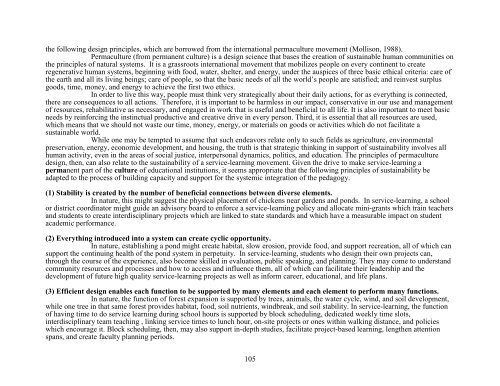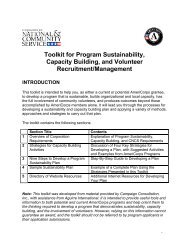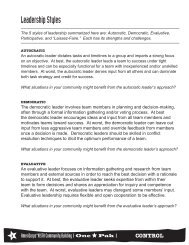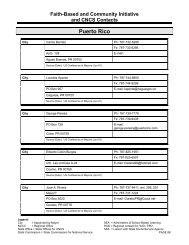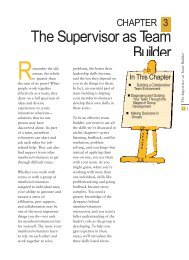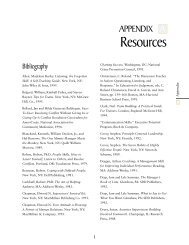MAKE IT LAST FOREVER: THE ... - National Service Resource Center
MAKE IT LAST FOREVER: THE ... - National Service Resource Center
MAKE IT LAST FOREVER: THE ... - National Service Resource Center
You also want an ePaper? Increase the reach of your titles
YUMPU automatically turns print PDFs into web optimized ePapers that Google loves.
the following design principles, which are borrowed from the international permaculture movement (Mollison, 1988).<br />
Permaculture (from permanent culture) is a design science that bases the creation of sustainable human communities on<br />
the principles of natural systems. It is a grassroots international movement that mobilizes people on every continent to create<br />
regenerative human systems, beginning with food, water, shelter, and energy, under the auspices of three basic ethical criteria: care of<br />
the earth and all its living beings; care of people, so that the basic needs of all the world’s people are satisfied; and reinvest surplus<br />
goods, time, money, and energy to achieve the first two ethics.<br />
In order to live this way, people must think very strategically about their daily actions, for as everything is connected,<br />
there are consequences to all actions. Therefore, it is important to be harmless in our impact, conservative in our use and management<br />
of resources, rehabilitative as necessary, and engaged in work that is useful and beneficial to all life. It is also important to meet basic<br />
needs by reinforcing the instinctual productive and creative drive in every person. Third, it is essential that all resources are used,<br />
which means that we should not waste our time, money, energy, or materials on goods or activities which do not facilitate a<br />
sustainable world.<br />
While one may be tempted to assume that such endeavors relate only to such fields as agriculture, environmental<br />
preservation, energy, economic development, and housing, the truth is that strategic thinking in support of sustainability involves all<br />
human activity, even in the areas of social justice, interpersonal dynamics, politics, and education. The principles of permaculture<br />
design, then, can also relate to the sustainability of a service-learning movement. Given the drive to make service-learning a<br />
permanent part of the culture of educational institutions, it seems appropriate that the following principles of sustainability be<br />
adapted to the process of building capacity and support for the systemic integration of the pedagogy.<br />
(1) Stability is created by the number of beneficial connections between diverse elements.<br />
In nature, this might suggest the physical placement of chickens near gardens and ponds. In service-learning, a school<br />
or district coordinator might guide an advisory board to enforce a service-learning policy and allocate mini-grants which train teachers<br />
and students to create interdisciplinary projects which are linked to state standards and which have a measurable impact on student<br />
academic performance.<br />
(2) Everything introduced into a system can create cyclic opportunity.<br />
In nature, establishing a pond might create habitat, slow erosion, provide food, and support recreation, all of which can<br />
support the continuing health of the pond system in perpetuity. In service-learning, students who design their own projects can,<br />
through the course of the experience, also become skilled in evaluation, public speaking, and planning. They may come to understand<br />
community resources and processes and how to access and influence them, all of which can facilitate their leadership and the<br />
development of future high quality service-learning projects as well as inform career, educational, and life plans.<br />
(3) Efficient design enables each function to be supported by many elements and each element to perform many functions.<br />
In nature, the function of forest expansion is supported by trees, animals, the water cycle, wind, and soil development,<br />
while one tree in that same forest provides habitat, food, soil nutrients, windbreak, and soil stability. In service-learning, the function<br />
of having time to do service learning during school hours is supported by block scheduling, dedicated weekly time slots,<br />
interdisciplinary team teaching , linking service times to lunch hour, on-site projects or ones within walking distance, and policies<br />
which encourage it. Block scheduling, then, may also support in-depth studies, facilitate project-based learning, lengthen attention<br />
spans, and create faculty planning periods.<br />
105


